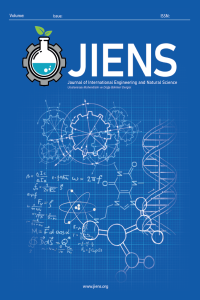Development of reactive digital printing process for cellulosic fabrics
Development of reactive digital printing process for cellulosic fabrics
Digital printing, Reactive dyeing, Cellulosic fabrics,
___
- Ujiie H (2006) Digital printing of textiles. The Woodhead Publishing Ltd., Cambridge p.202-204
- Kanık M (2004) Tekstil teknolojisi ve kimyasındaki son gelişmeler sempozyumu. s.191-203
- Leelajariyakul S, Noguchi H, Kiatkamjornwong S (2008) Surface-modified and micro-encapsulated pigmented inks for ink jet printing on textile fabrics. Progress in Organic Coatings. 62:145-161. https://doi.org/10.1016/j.porgcoat.2007.10.005
- Kuo CH, Shiu JW, Rwei SP (2022) Preparation and characterization of PMMA encapsulated carbon black for water-based digital jet printing ink on different fibers of cotton and PET. Colloids and Surfaces A: Physicochemical and Engineering Aspects, 648, 129450.
- Kuang M, Wang L, Song Y (2014) Controllable printing droplets for high-resolution patterns. Advanced materials (Deerfield Beach, Fla.). 26. 10. https://doi.org/1002/adma.201305416.
- Menard E, Meitl MA, Sun Y, Park JU, Shir DJ, Nam YS, Jeon S, Rogers JA (2007) Micro- and nanopatterning techniques for organic electronic and optoelectronic systems. Chem Rev 107(4):1117-60. https://doi.org/10.1021/cr050139y.
- Nie Z, Kumacheva E (2008) Patterning surfaces with functional polymers. Nature Materials 7:277-90. https://doi.org/10.1038/nmat2109
- Hauser P, Tabba AH (2001). Improving the environmental and economic aspects of cotton dyeing using a cationised cotton. Review of Progress in Coloration and Related Topics 117:282-288.
- Khatri A, Peerzada M, Mohsin M, White M (2015) A review on developments in dyeing cotton fabrics with reactive dyes for reducing effluent pollution. Journal of Cleaner Production 87:50-57. https://doi.org/10.1016/j.jclepro.2014.09.017
- Montazer M, Malek MAR, Rahimi A. (2007) Salt free reactive dyeing of cationized cotton. Fibers and Polymers 8:608-612. https://doi.org/10.1007/BF02875997
- Nallathambi A, Rengaswami GDV (2016) Salt-free reactive dyeing of cotton hosiery fabrics by exhaust application of cationic agent. Carbohydr Polym 5(152):1-11. https://doi.org/10.1016/j.carbpol.2016.06.087
- Wang L, Ma W, Zhang S, Teng X, Yang J (2009) Preparation of cationic cotton with two-bath pad-bake process and its application in salt-free dyeing. Carbohydrate Polymers 78:602-608. https://doi.org/10.1016/j.carbpol.2009.05.022
- Aston SO, Provost JR, Masselink H. (2008) Jet printing with reactive dyes. Journal of the Society of Dyers and Colourists 109(4):147–152. https://doi.org/10.1111/J.1478-4408.1993.TB01546.X
- Tyler DJ (2005) Textile digital printing technologies. Textile Progress 37(4):1-65.
- T.C. Millî Eğitim Bakanlığı (2013) Tekstil teknolojisi, dijital baskıya hazırlık, Ankara, 2013.
- Eser B, Ozguney A, Ozerdem A (2012) Investigation of the usage of different thickening agents in ink-jet printing with reactive dyes. Industria textilă 63:85-90.
- Choi PSR, Yuen CWM, Ku SKA, Kan CW (2005) Digital ınk-jet printing for chitosan-treated cotton fabric. In: Fibers and Polymers 6(3):229-234. https://doi.org/10.1007/BF02875647
- Gutjahr H, Koch RR (1994) Direct print coloration. Textile Printing, 2nd Edn., Ed. Miles, L.W.C., Bradford: SDC, pp 139-195.
- Achwal W. B (2002) Textile chemical principle of digital textile printing. Colourage, 49(12):33.
- Chen W, Wang G, Bai Y (2002) Best for wool fabricprinting – digital inkjet. Textile Asia 33(12):37.
- Rüzgar A (2019) Rotasyon ve dijital reaktif baskıların çevresel etkilerinin yaşam döngüsü analizi tekniğiyle karşılaştırılması, Yüksek Lisans Tezi, Tekstil Mühendisliği Anabilim Dalı, Fen Bilimleri Enstitüsü, Bursa Uludağ Üniversitesi, Bursa, Türkiye.
- Marianofreire E (2006) Ink jet printing technology (CIJ/DOD): Digital Printing of Textiles, Editor: Ujiie, H Woodhead Publishing Limited, Cambridge, England, pp 29- 52.
- Kanık M (2013) Dijital baskı teknolojileri ve tekstil sanayindeki uygulamaları ders notları. Uludağ Üniversitesi, Fen Bilimleri Enstitüsü, Tekstil Mühendisliği, Bursa, Türkiye.
- Acar S (2020) Viskon ve viskon elastan karışım kumaşlarının dijital inkjet baskısına yeni bir yaklaşım, Yüksek Lisans Tezi, Fen Bilimleri Enstitüsü, Tekstil Eğitimi Anabilim Dalı, Tekstil Eğitimi Programı, Marmara Üniversitesi, İstanbul, Türkiye.
- Başlangıç: 2021
- Yayıncı: İdris Karagöz
Hakan ÖZTÜRKMEN, Yusuf USTA, Serkan TOROS, Fahrettin ÖZTÜRK
Investigation of effect of chestnut sawdust on mechanical properties of epoxy matrix composites
Eksik tahrikli döner ters sarkaç sisteminin geribeslemeli doğrusallaştırma tabanlı kademeli kontrolü
Seda BEKİN AÇAR, Mehmet Atilla TASDELEN, Bağdagül KARAAĞAÇ
Development of reactive digital printing process for cellulosic fabrics
Halil İbrahim TURGUT, Aslı BALÇAK GİRGİN, Özlem YARAR
Converting polyolefin fibres into CO2 adsorbent by radiation induced grafting
Noor Ashikin MOHAMAD, Nur Afifah ZUBAIR, Mohamed Mahmoud NASEF, Teo Ming TING
Nesibe YEŞİLDAĞ, Ömer Faruk ÜNSAL, Ramazan GÖMEÇ, Ayşe BEDELOĞLU
PVDF nanofibers composite containing core-shell (ZnO@ZIF-8) for use in smart textile applications
Miladi ATIGHI, Moein JALALI, Mahdi HASANZADEH, Seyed Mansour BIDOKI
